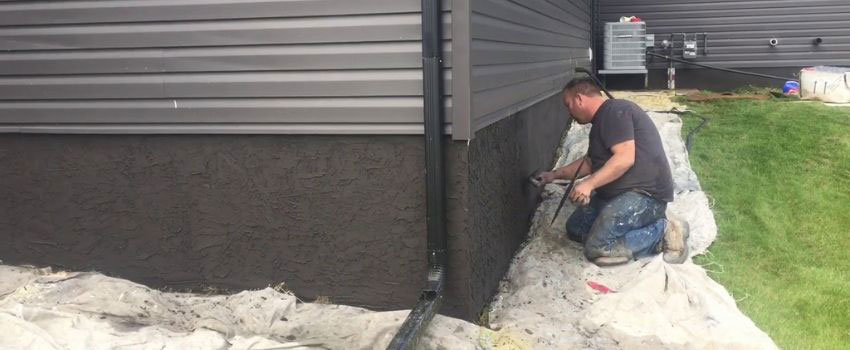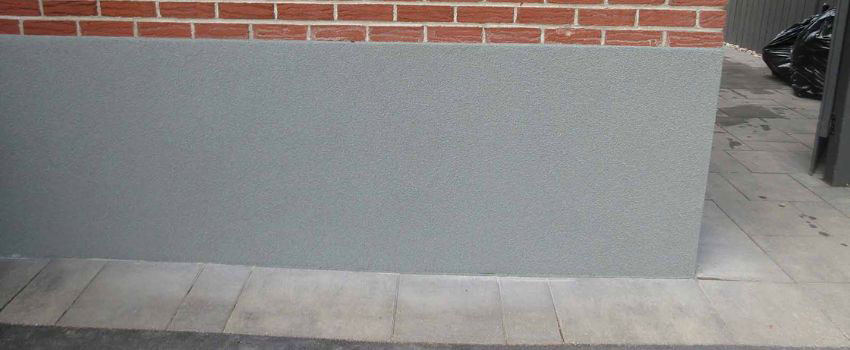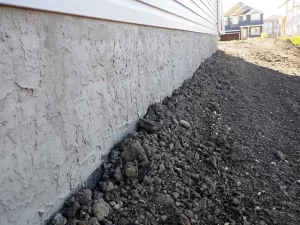Your Guide to Parging Options in Edmonton
There are various parging techniques used in Edmonton homes, including:
- Traditional cement parging
- Acrylic parging
- EIFS parging
Each of these parging techniques offers unique benefits depending on your needs. Call (780) 710-3972 to learn more about each technique.
Understanding The Basics of Parging in Edmonton AB
Parging is a technique used to coat and protect masonry surfaces. It is vital for maintaining a building’s structural integrity. Parging is more than just a cosmetic fix. It protects against weather elements like rain, snow, and wind, which can gradually wear down brick or concrete. Over time, this protective layer helps prevent moisture from seeping into the walls, reducing the risk of cracks and other structural damage.
The mixture used for parging includes a blend of cement, lime, and sand. This mixture creates a durable coating that adheres well to masonry surfaces.
The application process involves cleaning the surface thoroughly to guarantee proper adhesion. Any loose debris, dirt, or old mortar needs to be removed. Once the surface is prepped, we apply the parging mixture using a trowel.
We spread it evenly to avoid any weak spots. The thickness of the layer should be consistent for optimum protection. By mastering these basics, we guarantee our parging efforts are effective and long-lasting.

EIFS Parging Method
Let’s explore the EIFS parging method, focusing on material composition and the application process.
We’ll also weigh its benefits and drawbacks. Understanding these aspects will help you decide if EIFS is the right choice for your project.
EIFS Material Composition
First, there’s the insulation board, typically made from expanded polystyrene (EPS). This lightweight material provides excellent thermal insulation and serves as the foundation for the system.
Next, we have the adhesive and mechanical fasteners used to attach the insulation board to the wall. The choice between adhesive and fasteners depends on the substrate and specific project requirements.
Then, there’s the base coat, which is a cementitious or polymer-based material applied over the insulation board. This layer also embeds a fiberglass mesh for added strength and impact resistance.
The fiberglass mesh is essential because it helps prevent cracks and guarantees the durability of the EIFS.
EIFS Application Process
- First, we prepare the surface by thoroughly cleaning it, ensuring no dust, dirt, or loose particles. Then, we apply a water-resistant barrier to protect the underlying structure from moisture.
- Next, we install the foam insulation boards, securing them tightly to create a uniform base. Once the insulation is in place, we apply a base coat, embedding a fiberglass mesh to add strength and flexibility to the parging layer. This step guarantees the parging will withstand environmental stresses without cracking.
- After the base coat dries, we apply the finish coat. We can choose from various textures and colors to match the aesthetic of your home. For best results, it’s important to apply this layer evenly, maintaining a consistent thickness.
Benefits and Drawbacks
The EIFS parging method offers numerous benefits, but it’s essential to weigh them against the potential drawbacks.
Benefits
One of the most notable advantages is its excellent insulation properties. EIFS can greatly reduce heating and cooling costs, making homes more energy-efficient.
EIFS provides a high level of design flexibility. You can choose from various textures and colors, allowing you to customize your home’s exterior look to match your aesthetic preferences.
Drawbacks
EIFS can be more expensive than traditional parging methods regarding material costs and labor. Installation requires skilled professionals, which can drive up the overall expense.
Another concern is moisture management. If not correctly installed, EIFS can trap moisture behind the walls, leading to mold growth and structural damage over time.
Maintenance is also key, as any cracks or damage to the EIFS layer need prompt repair to prevent water infiltration.

Traditional Cement Parging Technique
Traditional cement parging involves layering a mix of cement, sand, and water onto masonry surfaces.
Traditional Cement Parging Application Process
- First, we ensure the surface is clean and free of any loose debris. We can use a wire brush or a pressure washer to remove dirt, dust, and old paint.
- Once the surface is prepped, we dampen it slightly, ensuring it’s not too wet but moist enough to help the cement adhere better.
- Next, we mix the cement parging material according to the manufacturer’s instructions. It’s essential to get the right consistency—not too runny or thick—so the mix spreads smoothly.
- We apply the first coat using a trowel, ensuring an even layer about 3/8 inch thick. We work in small sections to maintain control and consistency.
- After the first coat is complete, we let it cure for about 24 hours. Once set, we apply a second, thinner coat to refine the surface texture and cover imperfections.
- We use a finishing trowel to smooth the surface or add a desired texture. Finally, we let the parging cure for at least 48 hours, protecting it from extreme weather to guarantee a durable finish.
Material Composition of Traditional Cement Parging
Traditional cement parging primarily comprises Portland cement, sand, and water. This basic mixture forms a robust and versatile base that covers masonry surfaces.
Portland cement is the key binding agent, providing strength and adhesion. The sand acts as a filler, giving the parge coat its texture and workability. Adding water initiates the chemical reaction that hardens the cement, turning it into a solid, protective layer.
We also include additives to enhance the mixture. For instance, lime is often added to improve flexibility and reduce the risk of cracking.
Some mixtures may incorporate synthetic fibers to increase tensile strength and durability. These fibers help the parging withstand minor movements and stress without compromising its integrity.
How to Maintain Traditional Cement Parging
- Look for signs of wear and tear, such as cracks or chips, and address them promptly. Ignoring minor damage can lead to larger issues that compromise the integrity of the parging. Regular inspections, especially after harsh weather conditions, help avoid potential problems.
- To extend the life of our cement parging, ensure proper drainage around the foundation. Water pooling near the surface can accelerate deterioration. Install gutters and downspouts that direct water away from the foundation.
- Additionally, applying a water-resistant sealant every few years provides extra protection against moisture infiltration.
- When repairs are necessary, use the same type of cement mix to maintain consistency and avoid mismatched patches. Cleaning the surface before applying new parging ensures better adhesion and a smoother finish.

Acrylic Parging Technique and Its Benefits
Acrylic parging offers enhanced durability and flexibility, making it an excellent choice for various surfaces. Acrylic parging can withstand harsh weather conditions, resist cracking, and maintain its appearance over time.
Unlike traditional cement-based parging, acrylic parging has polymers that add elasticity, preventing the surface from cracking due to temperature fluctuations or minor structural shifts.
One of the standout benefits of acrylic parging is its breathability. This characteristic allows moisture to escape from the underlying wall, reducing the risk of mold and mildew development. Acrylic parging comes in various colors and finishes, allowing you to match or complement your home’s exterior design.
Additionally, acrylic parging adheres well to different substrates, including concrete, brick, and foam insulation. This versatility means you can apply it to various parts of your home without worrying about compatibility issues.
Maintenance is relatively straightforward, requiring just occasional cleaning to keep it looking fresh. It’s also resistant to fading, so the vibrant look lasts longer, enhancing your home’s curb appeal.
Surface Preparation Tips When Parging Your Edmonton Home
- Before you start parging, ensure the surface is clean, dry, and free of any loose material.
- Begin by thoroughly cleaning the wall. Use a wire brush to remove any dirt, dust, or old mortar that may interfere with the adhesion of the new parge coat. Rinsing the surface with water can help, but you must ensure it’s completely dry before moving on.
- Next, inspect the wall for any cracks or holes. If you spot any, fill them with a suitable patching compound and allow it to cure completely. This step is essential because any imperfections can affect the overall finish and integrity of the parging.
- Once the wall is clean and repaired, consider applying a bonding agent. This will enhance the adhesion between the existing surface and the new parge coat. You can use a brush or roller to apply the bonding agent uniformly.
Common Parging Mistakes
- One of the biggest parging mistakes is not thoroughly cleaning the surface before applying the parging mix. Dirt, debris, and loose materials can prevent the mix from adhering properly, leading to cracks and peeling over time.
- Another common error is using the wrong sand, cement, and water mix ratio. An improper mix can either be too weak or too strong, causing it to crumble or fail to bond correctly. It’s vital to follow the manufacturer’s guidelines for the best mix.
- Another pitfall is applying too thick a layer at once. If you slap on a thick coat in one go, it might look good initially but will likely crack as it dries. Instead, apply thinner layers and allow each to set before adding the next.
- Lastly, neglecting to keep the freshly parged surface moist can lead to premature drying and cracking. Make sure you mist the surface regularly to promote even curing.
Parging Maintenance Tips for Edmonton Homes
Regular maintenance and upkeep are essential to ensure your parging remains durable and looks its best.
- First, inspect your parging regularly, ideally twice a year, to identify any cracks, chips, or signs of wear. Catching these issues early allows you to address them before they become bigger problems.
- Cleaning your parged surfaces is another key step. Dirt and grime can accumulate over time, leading to a dull appearance. A simple mix of water and mild detergent, applied with a soft brush, will keep your parging clean and fresh. Avoid using high-pressure washers, as they can damage the surface.
- If you notice any small cracks or chips, repair them promptly. To fill in these imperfections, use a patching compound specifically designed for parging. Applying the compound smoothly and allowing it to cure properly will ensure the repair blends seamlessly with the existing surface.
- Consider applying a sealant to protect your parging from moisture and harsh weather conditions. A high-quality sealant creates a barrier that prolongs the life of your parging and keeps it looking new. By following these maintenance steps, you can enjoy a beautiful and long-lasting parged surface.
Depend Exteriors Offers Parging Installation in Edmonton AB
Depend Exteriors specializes in parging installation for residential and commercial properties in Edmonton, AB. Our services include concrete parging, parging exterior foundation walls, and parging basement walls.
We ensure durable results that protect your foundation from moisture and enhance its appearance. Our team uses durable materials and proven techniques for a smooth, lasting finish.




